

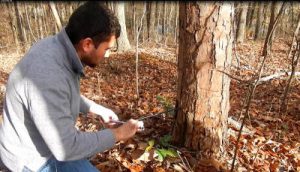


On April 9, 2011, IQPR faculty and students planned and led hands-on research on past climates and environments with local Girl Scouts, using fossil-rich sediments from mastodon excavations in New York donated by the Paleontological Research Institute. The authentic STEM research experience they provided to girls used lesson plans and materials developed as part of the University of Tennessee’s GK-12 Earth project (see “Mastodon Matrix Project“).
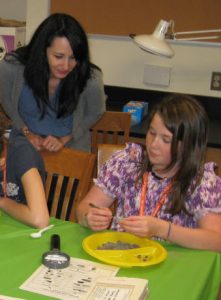
IQPR graduate student Niki Garland looks over the shoulder as a girl scout explores the mastodon “mud!”
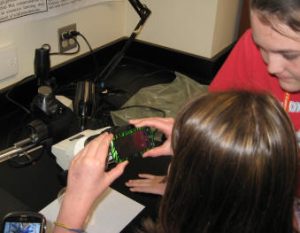
A highlight for some of the girls was snapping photos of fossils on their phones, through the dissecting scope!
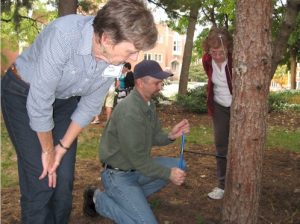
IQPR M.S. student Mathew Boehm demonstrates how to use an increment borer to area middle school teachers.
On October 19, 2010, faculty and students involved with our initiative presented a workshop to area teachers on tree-ring analysis. This workshop was also sponsored by the University of Tennessee GK-12 Earth Project and by the Tennessee Geographic Alliance.
Our proposal to establish the IQPR listed the objective of involving two K-12 teachers in summer 2010 field and laboratory research on Quaternary paleoclimates. We’re pleased that Ann McGhee and Kimberly Kennard assisted in IQPR projects to learn techniques for understanding the earth’s paleoclimate.
Ann McGhee
Ms. Ann McGhee, science teacher at Jefferson Middle school in Jefferson City, Tennessee, helped Henri Grissino-Mayer and Ph.D. student Grant Harley collect increment cores from slash pines in the Florida Keys. Her participation in the research was funded by the NSF through the University of Tennessee GK-12 Earth Project.
Kimberly Kennard
Ms. Kimberly Kennard, biology teacher at Fulton High School in Knoxville, traveled to the Guadalupe and Davis Mountains of Texas with Ph.D. student Matthew Valente to help Matt collect modern suface samples to calibrate fossil pollen records from Cuatro Cienegas, Mexico. Her participation in Matt’s field work was funded by NSF through a doctoral dissertation research grant awarded to Matt and advisor Sally Horn.
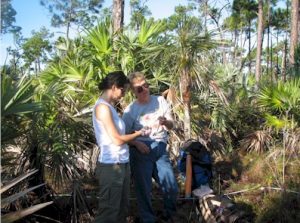
Jefferson Middle School science teacher Ann McGhee (right) assists IQPR M.S. student Niki Garland collecting cores from slash pines in the Florida Keys.
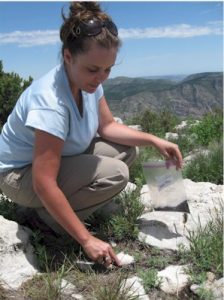
Fulton High School biology teacher Kim Kennard taking soil samples for Chihuahuan Desert modern pollen rain study.
David G. Anderson
- Anderson, David G. 2012. The Pleistocene Human Colonization of Interior North America. National Park Service Archeology Program 2012 ArcheoThursday Webinar series. Available online at http://www.nps.gov/archeology/tools/webinars.htm (Use IE for best results).
- Anderson, David G. 2012. Climate Change and Culture: Lessons from the Past for the Future. Pavilion Auditorium, Pavilion Building, 109 State Street, Montpelier. 12 September 2012. Vermont Archaeology Month. (Invited lecture). Panel discussion followed with Dr. John Crock (UVM, Consulting Archaeology Program), Dr. Lesley-Ann Dupigny-Giroux (UVM, State Climatologist), Kate McCarthy (VNRC), VT State Archeologist Giovanna Peebles, and Brian Woods (Governor’s Climate Cabinet) on lessons learned and what we should be doing now.
- Anderson, David G. 2012. Archeology and Climate Change. Interview on the Mark Johnson show, WDEV, Waterbury, Vermont, 12 September 2012. (University of Tennessee professor discusses how climate change affected earlier societies). Interview available at http://blog.markjohnsonshow.net/2012/09/13/91212-dave-anderson-archeologyclimate-change.aspx.
- Anderson, David G. 2011. The Initial Human Colonization of Interior North America. A presentation for Second International Conference on the Great Migrations: Asia to America, sponsored by the Permanent Delegation of the Republic of Kazakhstan to UNESCO, The Embassy of the Republic of Kazakhstan to the United States of America, and the Harriman Institute of Columbia University. New York City, New York. 1 December 2011. Invited speaker and participant.
- David G. Anderson, D. Shane Miller, Tom Pertierra, Derek Anderson, Thad Bissett, Stephen Carmody, Tracy Hadlett, Erik N. Johanson, Ashley M. Smallwood, and Sarah Walters, 16 stellar University of Tennessee undergraduate students, and numerous volunteers. 2010. The Cumberland River/Midsouth Paleoindian Survey Project: What We Did and Learned This Summer. Scottsboro Community Club, Scottsboro, Tennessee, 9 August 2010, and on 10 August 2010 Hells Bend Outdoor Center Nashville, Tennessee.
- David G. Anderson, 2010. Shiloh Indian Mounds National Historic Landmark: Research Results of the 1999-2004 Field Program at Mound A. Bells Bend Outdoor Center, 22 July 2010, Nashville, Tennessee.
- David G. Anderson, D. Shane Miller, Tom Pertierra, Derek Anderson, Thad Bissett, Stephen Carmody, Tracy Hadlett, Erik N. Johanson, Ashley M. Smallwood, and Sarah Walters, 16 stellar University of Tennessee undergraduate students, and numerous volunteers. 2010 The Cumberland River/Midsouth Paleoindian Survey Project. Bells Bend Outdoor Center Nashville, Tennessee (by Miller and Anderson), 8 July 2010, and on 18 July 2010 at the Scottsboro Community Club, Scottsboro, Tennessee (by Anderson).